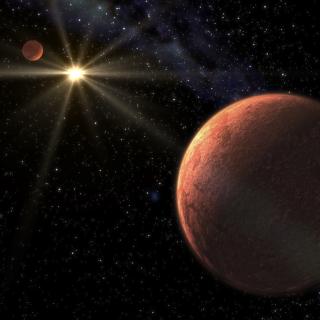Bibcode
von Stauffenberg, A.; Trifonov, T.; Quirrenbach, A.; Reffert, S.; Kaminski, A.; Dreizler, S.; Ribas, I.; Reiners, A.; Kürster, M.; Twicken, J. D.; Rapetti, D.; Caballero, J. A.; Amado, P. J.; Béjar, V. J. S.; Cifuentes, C.; Góngora, S.; Hatzes, A. P.; Henning, Th.; Montes, D.; Morales, J. C.; Schweitzer, A.
Bibliographical reference
Astronomy and Astrophysics
Advertised on:
8
2024
Journal
Citations
0
Refereed citations
0
Description
Context. GJ 581 is a nearby M dwarf known to host a packed multiple planet system composed of two super-Earths and a Neptune-mass planet. We present new orbital analyses of the GJ 581 system, utilizing recent radial velocity (RV) data obtained from the CARMENES spectrograph combined with newly reprocessed archival data from the HARPS and HIRES spectrographs.
Aims: Our aim was to analyze the post-discovery spectroscopic data of GJ581, which were obtained with CARMENES. In addition, we used publicly available HIRES and HARPS spectroscopic data to seek evidence of the known and disputed exoplanets in this system. We aimed to investigate the stellar activity of GJ 581 and update the planetary system's orbital parameters using state-of-the-art numerical models and techniques.
Methods: We performed a periodogram analysis of the available precise CARMENES, HIRES, and HARPS RVs and of stellar activity indicators. We conducted detailed orbital analyses by testing various orbital configurations consistent with the RV data. We studied the posterior probability distribution of the parameters fit to the data and we explored the long-term stability and overall orbital dynamics of the GJ 581 system.
Results: We refined the orbital parameters of the GJ 581 system using the most precise and complete set of Doppler data available. Consistent with the existing literature, our analysis confirms that the system is unequivocally composed of only three planets detectable in the present data, dismissing the putative planet GJ 581 d as an artifact of stellar activity. Our N-body fit reveals that the system's inclination is i = 47.0−13.0+14.6 deg, which implies that the planets could be up to 30% more massive than their previously reported minimum masses. Furthermore, we report that the GJ 581 system exhibits long-term stability, as indicated by the posterior probability distribution, characterized by secular dynamical interactions without the involvement of mean motion resonances.
Aims: Our aim was to analyze the post-discovery spectroscopic data of GJ581, which were obtained with CARMENES. In addition, we used publicly available HIRES and HARPS spectroscopic data to seek evidence of the known and disputed exoplanets in this system. We aimed to investigate the stellar activity of GJ 581 and update the planetary system's orbital parameters using state-of-the-art numerical models and techniques.
Methods: We performed a periodogram analysis of the available precise CARMENES, HIRES, and HARPS RVs and of stellar activity indicators. We conducted detailed orbital analyses by testing various orbital configurations consistent with the RV data. We studied the posterior probability distribution of the parameters fit to the data and we explored the long-term stability and overall orbital dynamics of the GJ 581 system.
Results: We refined the orbital parameters of the GJ 581 system using the most precise and complete set of Doppler data available. Consistent with the existing literature, our analysis confirms that the system is unequivocally composed of only three planets detectable in the present data, dismissing the putative planet GJ 581 d as an artifact of stellar activity. Our N-body fit reveals that the system's inclination is i = 47.0−13.0+14.6 deg, which implies that the planets could be up to 30% more massive than their previously reported minimum masses. Furthermore, we report that the GJ 581 system exhibits long-term stability, as indicated by the posterior probability distribution, characterized by secular dynamical interactions without the involvement of mean motion resonances.
Full Tables A.2, A.3, and Tables A.4, A.5 are available at the CDS via anonymous ftp to cdsarc.cds.unistra.fr (ftp://130.79.128.5) or via https://cdsarc.cds.unistra.fr/viz-bin/cat/J/A+A/688/A112
Related projects

Very Low Mass Stars, Brown Dwarfs and Planets
Our goal is to study the processes that lead to the formation of low mass stars, brown dwarfs and planets and to characterize the physical properties of these objects in various evolutionary stages. Low mass stars and brown dwarfs are likely the most numerous type of objects in our Galaxy but due to their low intrinsic luminosity they are not so
Rafael
Rebolo López

Exoplanets and Astrobiology
The search for life in the universe has been driven by recent discoveries of planets around other stars (known as exoplanets), becoming one of the most active fields in modern astrophysics. The growing number of new exoplanets discovered in recent years and the recent advance on the study of their atmospheres are not only providing new valuable
Enric
Pallé Bago